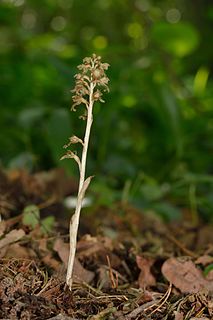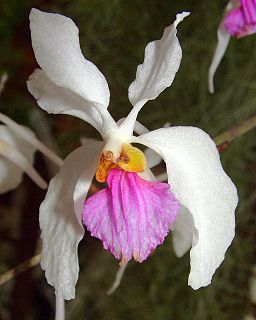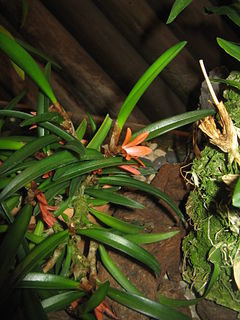
Octomeria is a plant genus belonging to the family Orchidaceae. The genus comprises about 150 species native to the Neotropics, mostly in Brazil.

Cup orchids are a group of about 72 species of orchids, found throughout much of tropical America. The generic name comes from Greek and refers to the protrusions on the stigma.

Neottia nidus-avis, the bird's-nest orchid, is a non-photosynthetic orchid, native to Europe, Russia and some parts of the Middle East. (Codes)

Holcoglossum is a genus of orchids, in the family Orchidaceae. It is native to China and Southeast Asia.
- Holcoglossum amesianum(Rchb.f.) Christenson - Yunnan, Assam, Mayanmar, Vietnam, Thailand, Laos, Cambodia
- Holcoglossum auriculatumZ.J.Liu, S.C.Chen & X.H.Jin - Yunnan, Mayanmar, Vietnam, Thailand
- Holcoglossum calcicolaSchuit. & P.Bonnet - Laos
- Holcoglossum flavescens(Schltr.) Z.H.Tsi - Fujian, Hubei, Sichuan, Yunnan
- Holcoglossum kimballianum(Rchb.f.) Garay - Yunnan, Mayanmar, Vietnam, Thailand, Laos
- Holcoglossum linearifoliumZ.J.Liu, S.C.Chen & L.J.Chen - Yunnan
- Holcoglossum lingulatum(Aver.) Aver. - Guangxi, Yunnan, Vietnam
- Holcoglossum nujiangenseX.H.Jin & S.C.Chen - Yunnan
- Holcoglossum omeienseX.H.Jin & S.C.Chen - Sichuan
- Holcoglossum quasipinifolium(Hayata) Schltr. - Taiwan
- Holcoglossum rupestre(Hand.-Mazz.) Garay - Yunnan
- Holcoglossum sinicumChristenson - Yunnan
- Holcoglossum subulifolium(Rchb.f.) Christenson - Hainan, Yunnan
- Holcoglossum wangiiChristenson - Yunnan, Guangxi, Vietnam
- Holcoglossum weixienseX.H.Jin & S.C.Chen - Yunnan
Benthamia is a genus of orchids. It contains 29 recognized species, all native to Madagascar, Mauritius and Réunion.
Cyphochilus is a genus of orchids. It contains 8 known species, all endemic to New Guinea.

Ceratostylis is a genus of orchids with more than 140 species distributed in China, India, Southeast Asia, New Guinea, the Philippines, and Melanesia.
Epiblastus is a genus of orchids with 22 known species distributed from New Guinea, Philippines, Maluku, Sulawesi, Fiji, the Solomons, the Bismarcks, Samoa and Vanuatu.

Campylocentrum is a genus of rare orchids native to Mexico, the West Indies, Central America and South America. One species (C. pachyrrhizum) extends its range into Florida.

Chiloschista, commonly known as starfish orchids or 异型兰属 is a genus of usually leafless, epiphytic or lithophytic orchids found in India, Southeast Asia and Australia.

Epidendrum secundum, one of the crucifix orchids, is a poorly understood reed stemmed species, which Dressler (1989) describes as "the Epidendrum secundum complex." According to Dressler, there are dozens of varieties, some of which appear to deserve species rank. Arditti and Ghani note that E. secundum has the distinction of bearing the longest seeds known in the Orchidaceae, 6.0 mm long. By comparison, the seeds of E. ibaguense are only 2.9 mm long.

Isabelia is an orchid genus formed by three tiny species and one natural hybrid, spread from the Northeast of Brazil to Argentina, which are closely related to the genus Constantia. During more than a century Isabelia was a genus formed by just one species, however, around 1968, it was merged with genus Neolauchea, also unispecific. In 2001, a third genus was added to it, Sophronitella.

Bulbophyllum abbreviatum is a species of orchid in the genus Bulbophyllum discovered in Madagascar and originally described by German botanist Rudolf Schlechter, from material collected by French botanist H. Perrier de la Bâthie in February 1912, which is now kept in the Muséum National d'Histoire Naturelle in Paris.

Malleola is a genus of flowering plants from the orchid family, Orchidaceae. It has about 30 species, native to Southeast Asia, China, New Guinea and Melanesia.
- Malleola aberrans(Schltr.) J.J.Sm.
- Malleola andamanicaN.P.Balakr. & N.Bhargava
- Malleola batakensis(Schltr.) Schltr.
- Malleola bicruris(J.J.Sm.) Garay
- Malleola brevisaccataJ.J.Sm.
- Malleola cladophylax(Schltr.) J.J.Sm. & Schltr.
- Malleola constrictaAmes
- Malleola culicifera(Ridl.) Garay
- Malleola dentiferaJ.J.Sm.
- Malleola eburneaW.Suarez & Cootes
- Malleola flammeaBoos, Cootes & W.Suarez
- Malleola forbesii(Ridl.) J.J.Sm.
- Malleola gautierensisJ.J.Sm.
- Malleola glomerata(Rolfe) P.F.Hunt
- Malleola honhoffiiSchuit. & A.Vogel
- Malleola insectifera(J.J.Sm.) J.J.Sm. & Schltr.
- Malleola juliaeP.O'Byrne
- Malleola kawakamii(J.J.Sm.) J.J.Sm. & Schltr.
- Malleola ligulata(J.J.Sm.) J.J.Sm.
- Malleola lyoniiAmes
- Malleola pallida(Schltr.) Schltr.
- Malleola palustris(J.J.Sm.) J.J.Sm. & Schltr.
- Malleola penangiana(Hook.f.) J.J.Sm. & Schltr.
- Malleola punctataJ.J.Wood & A.L.Lamb
- Malleola sanguinicorsP.O'Byrne & J.J.Verm.
- Malleola seidenfadeniiChristenson
- Malleola serpentina(J.J.Sm.) Schltr.
- Malleola sphingoidesJ.J.Sm.
- Malleola steffensii(Schltr.) J.J.Sm. & Schltr.
- Malleola sylvestris(Ridl.) Garay
- Malleola warianaSchltr.
- Malleola witteana(Rchb.f.) J.J.Sm. & Schltr.

Cyclopogon elatus is a species of terrestrial orchids. It is widespread across much of Latin America from Mexico to Argentina, as well as in the West Indies and southern Florida.

Erycina pusilla is a species of flowering plants, which is a tiny orchid with an overall size of 2.5 to 3.5 cm from the orchid family, Orchidaceae. Its species are native to Mexico, Central America, South America and Trinidad. The leaves are shaped like a lance head (lanceolate) and arranged in a fan. Unlike other similar orchids, E. pusilla never develops lengthwise folded leaves or extra storage organs (pseudobulbs).
Orchid mycorrhizae are symbiotic relationships between the roots of plants of the family Orchidaceae and a variety of fungi. All orchids are myco-heterotrophic at some point in their life cycle. Orchid mycorrhizae are critically important during orchid germination, as an orchid seed has virtually no energy reserve and obtains its carbon from the fungal symbiont.














